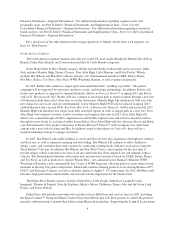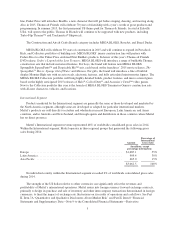Mattel 2014 Annual Report Download - page 20
Download and view the complete annual report
Please find page 20 of the 2014 Mattel annual report below. You can navigate through the pages in the report by either clicking on the pages listed below, or by using the keyword search tool below to find specific information within the annual report.If Mattel does not successfully identify or satisfy consumer preferences, its results of operations may be
adversely affected.
Mattel’s business and operating results depend largely upon the appeal of its toy products. Consumer
preferences, particularly with children as the end users of Mattel’s products, are continuously changing.
Significant, sudden shifts in demand are caused by “hit” toys and trends, which are often unpredictable. Mattel
offers a diverse range of products for children of all ages and families that includes, among others, toys for
infants and preschoolers, girls’ toys, boys’ toys, youth electronics, digital media, hand-held and other games,
puzzles, educational toys, media-driven products, and fashion-related toys. Mattel competes domestically and
internationally with a wide range of large and small manufacturers, marketers and sellers of toys, video games,
consumer electronics such as tablets and mobile devices, and other play products, as well as retailers, which
means that Mattel’s market position is always at risk. Mattel’s ability to maintain its current product sales, and
increase its product sales or establish product sales with new, innovative toys, will depend on Mattel’s ability to
satisfy play preferences, enhance existing products, develop and introduce new products, and achieve market
acceptance of these products. These challenges are intensifying due to recent trends towards shorter life cycles
for individual toy products, the phenomenon of children outgrowing traditional toys at younger ages, and an
increasing use of more sophisticated technology in toys. If Mattel does not successfully meet the challenges
outlined above in a timely and cost-effective manner, demand for its products could decrease, and Mattel’s
revenues, profitability and results of operations may be adversely affected.
High levels of competition and low barriers to entry make it difficult to achieve, maintain, or build upon
the success of Mattel’s brands, products, and product lines.
Mattel faces competitors who are also constantly monitoring and attempting to anticipate consumer tastes,
seeking ideas which will appeal to consumers and introducing new products that compete with Mattel’s products.
In addition, competition for access to entertainment properties could lessen Mattel’s ability to secure, maintain,
and renew popular licenses to entertainment products developed by other parties and licensed to Mattel or require
Mattel to pay licensors higher royalties and higher minimum guaranteed payments in order to obtain or retain
these licenses. In addition, the barriers to entry for new participants in the toy products industry are low. In a very
short period of time, new market participants with a popular product idea or entertainment property can become a
significant source of competition for Mattel and its products. If demand for Mattel’s brands, products and product
lines is reduced as a result of these factors, Mattel’s results of operations may be adversely affected.
Inaccurately anticipating changes and trends in popular culture, media and movies, fashion, or technology
can negatively affect Mattel’s sales.
Successful movies and characters in children’s literature affect play preferences, and many toys depend on
media-based intellectual property licenses. Media-based licenses can cause a line of toys to gain immediate
success among children, parents, or families. Trends in media, movies, and children’s characters change swiftly
and contribute to the transience and uncertainty of play preferences. In addition, certain developments in the
entertainment industry, including labor strikes, could cause delay or interruption in the release of new movies and
television programs and could adversely affect the sales of Mattel’s toys based on such movies and television
programs. Mattel responds to such trends and developments by modifying, refreshing, extending, and expanding
its product offerings on an annual basis. If Mattel does not accurately anticipate trends in popular culture,
movies, media, fashion, or technology, its products may not be accepted by children, parents, or families and
Mattel’s revenues, profitability, and results of operations may be adversely affected.
Mattel’s failure to successfully market or advertise its products could have an adverse effect on Mattel’s
business, financial condition, and results of operations.
Mattel’s products are marketed worldwide through a diverse spectrum of advertising and promotional
programs. Mattel’s ability to sell products is dependent in part upon the success of these programs. If Mattel does
not successfully market its products or if media or other advertising or promotional costs increase, these factors
could have an adverse effect on Mattel’s business, financial condition, and results of operations.
14
























